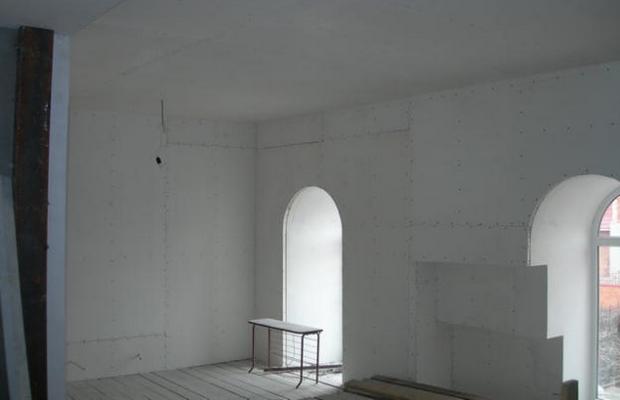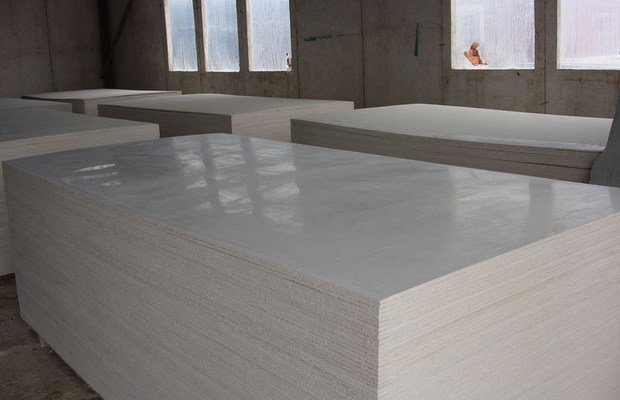Magnesium glass sheet - the advantages of an innovative material + Video
Magnesium glass sheet is an innovative building material used for various indoor and outdoor decoration activities. It has unique technical characteristics, which determine a wide scope of its application.
1
The products of interest to us are called differently - magnesite slabs, magnesite, construction sheet, cement-magnesium slabs, novolist, LSU. Under all these definitions, one material is hidden, made on the basis of chloride and magnesium oxide, and having a special reinforcing layer on both sides. As the latter, fiberglass and expanded perlite are usually used, sometimes synthetic non-woven material.
Glass-magnesium sheet
The specified composition determines the special technical and operational characteristics of LSU. Magnesite glass sheets have:
- High impact resistance. Under tangible mechanical effects, LSU does not crumble, cracks and splits do not form on its surface.
- Excellent resistance to subzero temperatures. Glass-magnesium sheets can be used at -50 ° C. However, they do not lose their unique properties.
- Low thermal conductivity. Its value for LSU from various manufacturers does not exceed 0.316 W / m * C.
- Sufficient density (from 0.85 to 1.01 g / cm).
- Increased (about 21 MPa) resistance to fracture in conditions of constantly high humidity.
- Excellent fire resistance. The unique composition of the described sheets allows them to withstand temperatures up to + 1200 ° for 2-3 hours. Note that under such extreme conditions, the glass-magnesium sheet does not emit any toxic compounds into the air and does not lose its properties.
- A small (up to 0.26%) indicator of hygroscopic deformation. If the LSU is completely immersed in water for three months, it will not change its characteristics.
- Environmental safety. The natural composition of novolist ensures its absolute harmlessness to the environment and to humans.
Also, magnesia glass sheets have excellent sound-absorbing characteristics. For example, a 6 mm thick slab provides a sound insulation index of 29 dB. The noise protection potential of wall and other surfaces made of LSU is 1.3–1.5 times higher than that of a standard wall made of bricks. In addition, the glass-magnesite sheet is allowed to be bent during transportation and installation to a radius of up to 280 cm. Such a high flexibility of products is due to the fact that they include a fiberglass reinforcing mesh. LSU also has some disadvantages. The problem is that the slabs we are interested in are not labeled.
In practice, it is very difficult to understand what class and quality of magnesite panels manufacturers offer. The only exceptions are the Etalon and Premium class sheets. They are usually labeled. But the products of the Economy and Standard classes are unrealistic to distinguish from each other. Other disadvantages of LSU are fragility and increased water absorption. These disadvantages of the material can negate all its advantages. It is worth noting here that these disadvantages are inherent in extremely low LSU class, which are produced by "incomprehensible" manufacturers. Premium boards have special additives. Due to this, the voiced shortcomings of the products are almost completely leveled.
2
The glass-magnesium sheet can have a thickness of 10, 12, 8, 3 and 6 mm. The geometrical dimensions of the slabs are different. At the same time, products with parameters 122x244 cm and 120x300 cm are considered the most in demand. The place of magnesite extraction (the basis of the described material) affects the color that the finished sheets have. It can be white, slightly bluish, or pinkish. Such a variety of products allows the use of magnesia glass sheet for a wide variety of purposes. In particular, for the following:
- finishing of floors;
- erection of interior partitions;
- wall cladding;
- preparation of the base base for the subsequent laying of a soft roof;
- production of door and furniture sheets, slopes for windows and doors, panel structures for formwork (non-removable);
- finishing of ceilings, heat-insulated and non-insulated mansard and attic rooms;
- facing of facades (in this case, any finishing material is necessarily mounted on the glass-magnesium sheets).

Decorating the room with a glass-magnesium sheet
In general, LSU is recommended for use as an excellent alternative to moisture-resistant wall and fiberboard and chipboard, plywood. The new sheets described in the article, which have special technical characteristics, are considered among professionals to be an impeccable basis for wallpapering, painting, installing ceramic tiles and other decorative products that are actively used today for finishing events.
If you plan to use glass-magnesium sheets for leveling floor bases, you need to purchase products that are 10-12 mm thick. Ceiling surfaces are best clad with 3 mm thick slabs. But to make the walls perfectly flat, 6-8 mm glass-magnesium sheets allow. LSUs are actively used for finishing production facilities where there is a constantly high operating temperature. The high fire resistance of magnesite significantly reduces the likelihood of fires in such rooms.
And its resistance to water causes widespread use of plates for facing objects with high humidity. The products we are considering are mounted in a bathhouse, in kitchens, in swimming pools. Important! To perform work in wet rooms, it is advisable to install a special glass-magnesium sheet, which is additionally processed to give it increased resistance to water. Such a product will serve in extreme conditions for decades without losing its strength. It is prohibited to use Economy and Standard sheets in saunas and swimming pools. Always decorate such rooms with higher class products!
3
The high strength and flexibility of the described products makes the process of their transportation, storage and installation as simple as possible. Here you should only take into account a few important recommendations:
- The LSU must be transported strictly in an upright position.
- If you plan to store the boards long enough, you should place them in a ventilated area on wood pallets.
- In cases where magnesite products have been exposed to high humidity for a long time, they must be thoroughly dried and only then used for their intended purpose.

Glass-magnesium sheets for construction
Magnesite glass sheet is easily cut, cut into specified parts, processed. The cutting of the product must be carried out on a flat surface in a horizontal position. Cutting is done with a construction knife. The only requirement for this tool is that it must be sharp. Sheets are cut according to a simple scheme. First, the slab is measured according to the required dimensions, cutting lines are applied to it. Then apply a ruler to the marked line (to the front of the product) and make a neat cut. After that, turn the LSU over and carefully (no need to exert excessive force) break it.
All you have to do is cut the reinforcing fiberglass (the same building knife is used) and proceed with the installation of the sheets. Magnesite slabs are produced with bevelling. Therefore, you do not need to carry out additional processing of products when installing them. It is allowed to cut new leaves with an electric jigsaw or a grinder. Instructions for working with slabs require you to pay special attention to high-quality drying of magnesite products. If it is saturated with water, it will not be easy to cut it with a power tool (wet sheets become very elastic, making them difficult to handle).
Magnesite can be milled, holes can be made in it with a jigsaw or a drill, and nails can be hammered into sheets. LSU fastening is most often performed (special notches are applied to them). The recommended step for installing hardware on a glass-magnesite sheet is 25 cm, from the edge of the plates they should be at a distance of at least 1 cm. The installation of self-tapping screws is always carried out from the center of the plate to its edges. Such a scheme excludes the possibility of product deformation. In addition, you need to ensure that the reinforcing fiberglass on the sheet is not overtightened when screwing in the fasteners.
Pro advice. Magnesite slab structures will be more durable if you install them in such a way that the fibers of the sheets are located not horizontally, but vertically. After installing the panels, be sure to putty the gaps between them, and then grout the gaps. It is also recommended to apply a primer to the magnesite surface.
